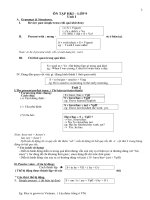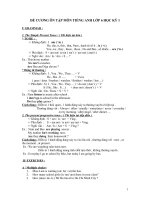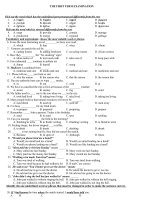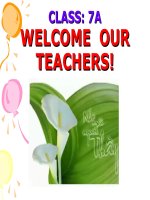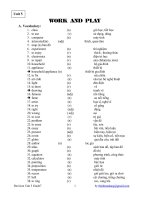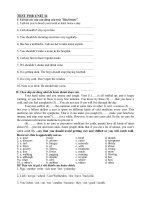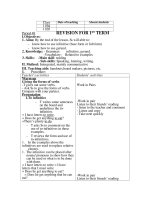Tài liệu Revision for first term
Bạn đang xem bản rút gọn của tài liệu. Xem và tải ngay bản đầy đủ của tài liệu tại đây (192.24 KB, 12 trang )
Class
Date of teaching Absent students
11B4
11B5
Period 48 REVISION FOR 1
ST
TERM
I.Objectives:
1. Aims: By the end of the lesson, Ss will able to:
- know how to use infinitive (base form or full form)
- know how to use gerund.
2. Knowledge: - Grammar: infinitive, gerund.
-Vocabulary: Related to examples
3. Skills: -Main skill: reading
- Sub-skills: Speaking, lstening, writing.
II. Method: Intergrated, mainly communicative
III. Teaching aids: handouts,board makers, pictures, etc.
I. Procedure:
Teacher s activities’ Students activities’
Warm up
Giving the forms of verbs
-T gives out some verbs.
- Ask Ss to give the forms of verbs.
Compare with your partner.
Presentation
1.To infinitive
- T writes some sentences
on the board and
underlines the to-
infinitive.
+ I have letters to write.
+ Does he get anything to eat?
+There’s plenty to do
- T asks Ss to comment on the
use of to-infinitives in these
examples.
- T reviews the form and use of
to-infinitives.
1. In the examples above the
infinitives are used to replace relative
clauses.
1. The infinitive can be placed after
Work in Pairs
-Work in pair
Listen to their friends’ reading
- listen to the teacher and comment
- Listen and copy
- Take note quickly
nouns/ pronouns to show how they
can be used or what is to be done
with them.
+ I have letters to write = I have letters
that I must write
+ Does he get anything to eat?
= Does he get anything that he can
eat?
2. Infinitive without to (bare
infinitive )
a. §éng tõ dïng sau c¸c ®éng tõ h×nh
th¸i (can, could ,may ,might, will,
would ,shall, should….)
eg: She can sing very beautifully.
She may be late.
b. Make and let.
C¸c ®éng tõ cã cÊu tróc ®éng tõ +bæ
ng÷+®éng tõ nguyªn mÉu kh«ng to‘’ ”
Eg: The cold weather made me feel
depressed.
They made me do it.
c. §éng tõ nguyªn mÉu kh«ng
to còng ®‘’ ’’ îc dïng trong c©u mÖnh
lÖnh ë d¹ng kh¼ng ®Þnh.
Eg: Go to the blackboard!
Stay at home!
Smile!
d. We can use a noun or pronoun
object+ bare infinitive after verbs of
perceptions such as feel, hear, watch,
see, notice, observe, perceive, smell
3. Gerund
- Ask Ss to give some verbs
/verbal phrases followed by the
Gerund
Expected answers: enjoy /miss
/risk /appreciate /avoid /detest
/dislike /It’s no use /can’t help /
postpone / mind /be worth /mention
/keep /count on /give up …
-Work in pair
Listen to their friends’ reading
- listen to the teacher and comment
- Listen and copy
- Take note quickly
-Work in pair
Listen to their friends’ reading
- listen to the teacher and comment
- Listen and copy
- Take note quickly
Checking:
- Ask Ss to give form and usage
of these verbs
Form: Verb +V +ing = gerund
Usage: To add information to what is
expressed in certain verbs
Practice
Choose the best answer in A, B, C or
D:
1. After … for 3 hours we stopped …
other … with us.
A. to walk - to let - to catch up
B. to walk - letting - catching up
C. walking - to let - catch up
D. walking - letting - catching up
2. I can’t help … . I caught a cold
yesterday from … in a draught.
A. sneezing - to sit B. to sneeze –
sitting
C. sneezing - sitting D. to sneeze -
to sit
Home-work
Prepare about participles
Work in pairs
Suggested answer:
1.C
2.B
- Listen and copy
Class
Date of teaching Absent students
11B4
11B5
Period 49 REVISION FOR 1
ST
TERM
( Cont )
I.Objectives:
1.Aims: By the end of the lesson, Ss will able to:
- distinguish gerund and present participle
- use perfect gerund and perfect participle.
2. Knowledge: - Grammar:gerund and present participle perfect gerund and
perfect
participle.
-Vocabulary: Related to examples
3. Skills: -Main skill: reading
- Sub-skills: Speaking, lstening, writing.
II. Method: Intergrated, mainly communicative
III. Teaching aids: handouts,board makers, pictures, etc.
II. Procedure:
Teacher s activities’ Students activities’
Warm up
What do you call it?
- Give some sentences with –ing form of verb.
- Ask Ss to give their name (if necessary)
- Give feedback and correction
Presentation
1. Gerund
- If necessary T reviews the form and uses of
gerunds. To save time T may give Ss the handout
below:
A gerunds is a noun made from a verb by adding ‘-ing’.
The gerund always has the same function as a noun
(although it looks like a verb), so it can be used:
+ as the subject of the sentence:
. Reading helps you learn English.
+ as the complement of the verb to be‘ ’:
. Her favorite hobby is reading.
+ after prepositions. The gerunds must be used when a
verb comes after a preposition:
. She is good at learning English.
. They re keen on windsurfing’ .
This is also true of certain expressions ending in a
preposition , e.g. in spite of , there s no point in’ …
. There s no point in typing the assignment’ .
. In spite of missing the train, we arrived on time.
+ after a number of phrasal verbs which are composed ‘ ’
of a verb + preposition / adverb
Example:
To look forward to ,to give up ,to be for / against, to take to,
to put off ,to keep on:
. I look forward to hearing from you soon. (at the
end of a letter)
. He kept on asking for a discount
+ in compound nouns
Example:
. a driving lesson , a swimming pool, bird-watching, train-
spotting
Teams
-Work in pair
Listen to their friends’
reading
- listen to the teacher and
comment
- Listen and copy
- Take note quickly
-Work in pair

